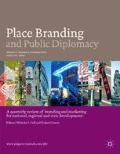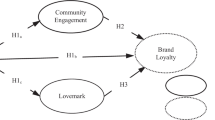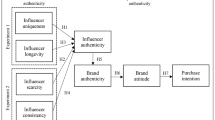Abstract
A nation brand is a complicated multi-facet construct. Even the critics of nation branding have admitted that nation brands exist. What they dispute is what nation branding refers to, and how a nation can be branded. This article aims to clarify some misunderstandings about nation branding. A conceptual framework is developed to illustrate the origins and different interpretations of the concept. Detailed comparisons are drawn between nation branding and commercial branding. A new definition is offered, which emphasises the need to shift from ‘branding’ the nation to nation image management. The use of nation image management is not only a change of terms but also helps overcome the public scepticism over the use of branding, and clarifies what can be ‘branded’ and what cannot be branded.

Similar content being viewed by others
References
Aaker, D.A. (1996) Building Strong Brands. New York: Free Press.
Aaker, D.A. and Joachimsthaler, E. (2002) Brand Leadership. Sydney: Free Press Business.
Albert, S. and Whetten, D.A. (1985) Organisation identity. In: L.L. Cummings and B.M. Staw (eds.) Research in Organisational Behaviour, Vol. 7. Greenwich, CT: JAI Press, pp. 263–269.
AMA. (1960) American marketing association, http://www.marketingpower.com/_layouts/Dictionary.aspx?dLetter=B, accessed 1 April 2009.
Anholt, S. (1998) Nation-brands of the twenty-first century. Journal of Brand Management 5 (6): 395–406.
Anholt, S. (2007) Competitive Identity: The New Brand Management for Nations, Cities and Regions. Basingstoke, UK: Palgrave Macmillan.
Anholt, S. (2008) Why nation branding does not exist? http://www.orangecontest.nl/docs/SimonAnholtNationBranding.pdf, accessed 1 April 2009.
Bond, R., McCrone, D. and Brown, A. (2003) National identity and economic development: Reiteration, recapture, reinterpretation and reputation. Nations and Nationalism 9: 371–391.
Connor, W. (1978) A nation is a nation, is a state, is an ethnic group, is a …. Ethnic and Racial Studies 1 (4): 377–400.
Dinnie, K. (2007) Nation Branding: Concepts, Issues, Practice. Oxford, UK: Butterworth Heinemann.
Fan, Y. (2004) Nation branding: Confusion and paradox. 33rd EMAC Conference, Murcia.
Fan, Y. (2005) Can a nation be marketed like products? PKU Business Review (9): 84–87, in Chinese.
Fan, Y. (2006) Banding the nation: What is being branded? Journal of Vacation Marketing 12 (1): 5–14.
Fan, Y. (2007) Soft power and nation branding. Brunel Business School Research Papers, http://bura.brunel.ac.uk/bitstream/2438/1863/4/Soft%2BPower%2BCh.pdf.
Fan, Y. (2008a) Soft power: The power of attraction or confusion. Place Branding and Public Diplomacy 4 (2): 147–158.
Fan, Y. (2008b) Self perception and significant others: A conceptual framework for nation image. The Sixth Conference of Asia Academy of Management, Taipei, 14–16 December.
Gilmore, F. (2002) A country – Can it be repositioned? Spain – The successful story of country branding. Journal of Brand Management 9 (4/5): 281–293.
Gudjonsson, H. (2005) Nation branding. Place Branding 1 (3): 283–298.
Hatch, M.J. and Schultz, M. (1997) Relations between organisational culture, identity and image. European Journal of Marketing 31: 356–365.
Hatch, M.J. and Schultz, M. (2000) Scaling the Tower of Babel: Relational differences between identity, image and culture in organization. In: M. Schultz, M.J. Hatch and M.H. Larsen (eds.) The Expressive Organization: Linking Identity, Reputation, and the Corporate Brand. Oxford, UK: Oxford University Press, pp. 13–35.
Highhouse, S., Brooks, M.E. and Gregarus, G. (2009) An organisational impression management perspective on the formation of corporate reputations. Journal of Management 35: 1481.
Jaffe, E.D. and Nebenzahl, I.D. (2001) National Image and Competitive Advantage: The Theory and Practice of Country-of-Origin Effect. Frederiksberg, Denmark: Copenhagen Business School Press.
Kabn, J. (2006) A brand-new approach. Foreign Policy, November/December, http://www.foreignpolicy.com/story/cms.php?story_id=3608, accessed 1 April 2009.
Kotler, P. and Gertner, D. (2002) Country as brand, product, and beyond: A place marketing and brand management perspective. Journal of Brand Management 9 (4/5): 249–261.
Kotler, P., Haider, D.H. and Rein, I.J. (1993) Marketing Places: Attracting Investment, Industry, and Tourism to Cities, States and Nations. New York: Free Press.
Lee, K.M. (2009) Nation branding and sustainable competitiveness of nations. PhD thesis, University of Twente, http://doc.utwente.nl/60754/1/thesis_K_M_Lee.pdf, accessed 1 April 2009.
Melissen, J. (2005) Wielding soft power, the new public diplomacy. Netherlands Institute of International Relations Clingendael. Clingendael Diplomacy Papers, No. 2.
Morgan, N., Pritchard, A. and Pride, R. (eds.) (2002) Destination Branding: Creating the Unique Destination Proposition. Woburn, MA: Butterworth-Heinemann.
Mselle, F. (2007) A critical analysis of the current state of knowledge of nation branding. MSc Thesis, Cranfield School of Management, https://dspace.lib.cranfield.ac.uk/handle/1826/2699, accessed 1 April 2009.
Nye, J.S. (2004a) The benefit of soft power. HBS Working Knowledge, http://hbswk.hbs.edu/archive/4290.html, accessed 1 April 2009 7–8.
Nye, J.S. (2004b) The decline of America's soft power. Foreign Affairs May/June.
O'Shaughnessy, J. and O'Shaughnessy, N.J. (2000) Testing the nation as a brand: Some neglected issues. Journal of Macromarketing 20 (1): 56–64.
Olins, W. (1999) Corporate Identity: Making Business Strategy Visible Through Design. Boston, MA: Harvard Business School Press.
Olins, W. (2002) Branding the nation – The historical context. Journal of Brand Management 9 (4/5): 241–248.
Papadopoulos, N. and Heslop, L. (1993) Product-Country Images: Impact and Role in International Marketing. London: Routledge.
Papadopoulos, N. and Heslop, L. (2002) Country equity and country branding: Problems and prospects. Journal of Brand Management 9 (4/5): 294–314.
Porter, M. (1990) The Competitive Advantage of Nations. New York: Free Press.
Quelch, J. and Jocz, K. (2004) Positioning the nation-state. Place Branding 1 (1): 74–79.
Rendon, J. (2003) When nations need a little marketing. New York Times, 23 November.
Roth, K.P. and Diamantopoulos, A. (2009) Advancing the country image construct. Journal of Business Research 62: 726–740.
Skinner, H. and Kubacki, K. (2007) Unravelling the complex relationship between nationhood, national and cultural identity, and place branding. Place Branding and Public Diplomacy 3 (4): 305–316.
Smith, A.D. (1991) National Identity. London: Penguin Books.
Stets, J.E. and Burke, P.J. (2000) Identity theory and social identity theory. Social Psychology Quarterly 63 (3): 224–337.
Szondi, G. (2007) The role and challenges of country branding in transition countries: The Central and Eastern Europe experience. Place Branding and Public Diplomacy 3 (1): 8–20.
Teslik, L.H. (2007) Nation branding explained. Council on Foreign Relations, http://www.cfr.org/publication/14776/nation_branding_explained.html.
Triandafyllidou, A. (1998) National identity and the ‘other’. Ethnic and Racial Studies 21 (4): 593–612.
Van Ham, P. (2001) The rise of the brand state: The postmodern politics of image and reputation. Foreign Affairs 10 October.
Whetten, D.A. and Mackey, A. (2002) A social actor conception of organisational identity and its implications for the study of organisational reputation. Business & Society 41 (4): 393–414.
Author information
Authors and Affiliations
Corresponding author
Rights and permissions
About this article
Cite this article
Fan, Y. Branding the nation: Towards a better understanding. Place Brand Public Dipl 6, 97–103 (2010). https://doi.org/10.1057/pb.2010.16
Received:
Revised:
Published:
Issue Date:
DOI: https://doi.org/10.1057/pb.2010.16




